Physical Address
304 North Cardinal St.
Dorchester Center, MA 02124
The labyrinth develops from the otic placode, which invaginates to become the otic pit and then pinches off to form the otic cyst, or otic vesicle.
The vertical canals are oriented at 45 degrees with regard to the sagittal plane, and the horizontal canal is tilted upward anteriorly about 30 degrees from the horizontal plane.
Scarpa's ganglion has two parts, the superior ganglion and the inferior ganglion. The former gives rise to nerves that supply the superior (anterior) and horizontal crista and the utricular macula; the latter supplies the posterior crista and the saccular macula.
The blood supply to the vestibular labyrinth is the labyrinthine artery, which has two branches: the anterior vestibular artery supplies the superior and horizontal ampullae and the utriculus and the common cochlear artery, which divides into the proper cochlear artery and the vestibulocochlear artery; the latter splits into a cochlear branch and the posterior vestibular artery, which supplies the posterior ampulla and the sacculus.
Vestibular hair cells are embedded in a matrix of supporting cells and form tight junctions with the supporting cells, which divide the labyrinth into endolymphatic and perilymphatic compartments.
Vestibular hair cells have a staircase arrangement of several rows of actin-filled stereocilia; these are anchored in a cuticular plate on their apical surface, and a single kinocilium defines the morphologic polarization for the hair cell.
Hair cells make synaptic contacts with their afferents by means of ribbon synapses. The three types of vestibular afferents are calyceal afferents, which enclose one or more type I hair cells; bouton afferents, which contact type II hair cells; and dimorphic afferents, which receive synaptic contacts from both types of hair cells. Efferents contact afferents and type II hair cells.
Calyceal afferents are found in the central (striolar) region of the crista (macula); bouton afferents are found in the peripheral (extrastriolar) region of the crista (macula); and dimorphic afferents are found throughout the sensory epithelium.
The vestibular nuclei are divided into four main subdivisions—superior, medial, lateral, and inferior—and further subdivided into several minor cell groups.
Vestibular afferents give rise to two branches in the vestibular nuclei: a rostral branch projects to the rostral part of the superior and medial vestibular nuclei and the cerebellum, and a caudal branch projects to the inferior and medial vestibular nuclei and to the ventrolateral part of the lateral vestibular nucleus. Saccular afferents project to the y group.
The superior and medial vestibular nuclei project to the oculomotor complex and are involved in the vestibulo-ocular reflex (VOR). The medial and inferior vestibular nuclei also give rise to the medial vestibulospinal tract, which runs in the medial longitudinal fasciculus. The latter tract projects to oculomotor and neck muscles for vestibulocollic or vestibulo-oculocervical reflexes.
The lateral vestibular nucleus contains giant Deiters cells. This nucleus gives rise to axons in the somatotopically organized lateral vestibulospinal tract, in which medium-sized cells project to ventral horn cells in the cervical spinal cord and large neurons project to the lumbar spinal cord.
The vestibular system is the system of balance and equilibrium; it consists of five distinct sensory organs: three semicircular canals that are sensitive to angular accelerations, or rotations, and two otoliths that are sensitive to linear accelerations such as motion in a vehicle or on an elevator. This chapter describes the anatomic basis for these functions.
The semicircular canals are arranged as a set of three orthogonal sensors—that is, each canal is at approximately right angles to the other two ( Fig. 129.1 ) and each of them is maximally sensitive to rotations that lie in the plane of that canal. The result of this arrangement is that the three canals can uniquely specify the direction and amplitude of any arbitrary head rotation. Each of the canals acts as an integrating accelerometer; the necessary stimulus for the canal is an angular acceleration, but the information encoded by the firing of the afferent nerve fiber is more closely related to angular velocity. Finally, the canals are organized into functional pairs, wherein both members of the pair lie in the same plane. Any rotation in that plane is excitatory to one of the members of the pair and inhibitory to the other. Although the two horizontal canals form a functional pair in the horizontal system, the situation is more complex in the vertical system. Here, the anterior canal on one side is parallel and coplanar with the posterior canal on the opposite side; for example, the right anterior canal and the left posterior canal form a functional pair.
Because the primary vestibular afferent fibers exhibit a substantial resting firing rate (60 to 80 spikes/sec in mammals), each canal is able to report rotations in either its excitatory direction by increasing its firing rate or its inhibitory direction by decreasing its firing rate; this observation explains why it is possible for a person to function reasonably well after the loss of one labyrinth.
The vestibular system forms the basis for many fundamental reflexes. For example, the vestibulocollic reflex manages head stabilization, the vestibulospinal reflex controls upright posture, and the VOR deals with retinal image stabilization. The last of these, the VOR, has been studied far more extensively than the others and is the best understood; this reflex forms the basis for most clinical testing (e.g., calorics, rotation tests). See Chapter 165 for vestibular physiology and Chapters 166 and 167 for clinical applications.
This chapter describes the anatomy of the VOR in some detail but without exploring every possible aspect. Many of the details described have been obtained from experiments in animals, principally the cat and monkey. Nevertheless, the information is applicable to humans because the vestibular system has changed little during the evolution of vertebrates.
The development of the inner ear is a complex process that starts at the beginning of the fourth week and is completed at about 25 weeks of gestational age. By that time, the vestibular apparatus has achieved adult form and size. A brief description of this process of development in human embryos follows; further details can be found by consulting the references herein. Excellent descriptions of the molecular aspects of development can be found in reviews by Wu and Kelley and Fukui and Raphael, who also discuss these molecules in relation to the potential regeneration of hair cells.
When the human embryo reaches the seven-somite stage (at about 22 days), the surface ectoderm that overlies the future site of the inner ear at about the level of the first occipital somite thickens to form the otic placode, which invaginates into the mesenchyme to form an otic pit. At about 30 days, the otic pit becomes pinched off and forms the otic vesicle or otocyst (see Fig. 129.1A ). Concurrently, at about 4 weeks, a portion of the neural crest migrates to the vicinity of the otic vesicle and becomes the acousticofacial ganglion. The geniculate ganglion soon migrates away from this cluster of neurons, which leaves the vestibulocochlear ganglion in close proximity to the otic vesicle.
Within 1 or 2 days after the otic vesicle is formed, its more medial portion, the endolymphatic diverticulum, becomes distinguishable from the lateral utriculosaccular chamber . This chamber differentiates by a constriction of its middle into an utricular chamber, which gives rise to the utriculus and the semicircular ducts, and a saccular chamber, which gives rise to the sacculus and the cochlea . The utricular chamber differentiates first by a rapid expansion into three diverticula. At about 35 days, the centers of these diverticula fuse and break down, leaving spaces around the perimeter that become the three semicircular ducts. The superior semicircular duct forms first, at about 6 weeks, with the posterior and lateral ducts forming soon after in that order. Dilations of one end of each of the semicircular ducts become the ampullae, and the ampullar ends and the opposite ends of the ducts remain connected to the utriculus.
The saccular chamber differentiates by expansion and coiling of the cochlear duct. This duct becomes separated from the sacculus by a narrowing of the duct at its dorsal end to form the ductus reuniens (see Fig. 129.1E and F ). Whereas morphogenesis proceeds within the otocyst, histogenesis of the sensory epithelium is also occurring. The arrival of afferent endings in the epithelium precedes the differentiation of hair cells. In the third week, a common macula, or specialized neuroepithelium, appears; its upper part becomes the utricular macula and crista ampullaris of the superior and lateral semicircular ducts, and its lower part becomes the saccular macula and crista ampullaris of the posterior semicircular duct. At 9 weeks, the hair cells in the vestibular end organs are well differentiated and exhibit typical synapses with nerve endings. The maculae reach adult form at about 14 to 16 weeks; the cristae, at about 23 weeks; and the organ of Corti, at about 25 weeks. The mesoderm surrounding the membranous labyrinth becomes the bony otic capsule, or bony labyrinth . The membranous labyrinth is suspended in fluid (perilymph) within the bony labyrinth by a loose connective tissue known as periotic tissue .
The vestibular apparatus is enclosed within a bony labyrinth, the vestibule, in the petrous portion of the temporal bone. The vestibular end organs include three semicircular canals, each oriented in a different plane, and two maculae, one roughly in the horizontal plane (the utricular macula) and one in the vertical plane (the saccular macula). There are two vertical semicircular canals, the anterior (or superior ) and posterior canals, and one horizontal canal, also known as the lateral canal. The vertical canals are oriented at roughly 45 degrees in relation to the sagittal plane, and the horizontal canal is tilted upward about 30 degrees anteriorly from the horizontal plane ( Fig. 129.2 ). The five vestibular end organs along with the cochlea are contained within an endolymph-filled membranous labyrinth, the endolymphatic space, which is contained in the perilymph-filled bony labyrinth, the perilymphatic space ( Fig. 129.3 ).
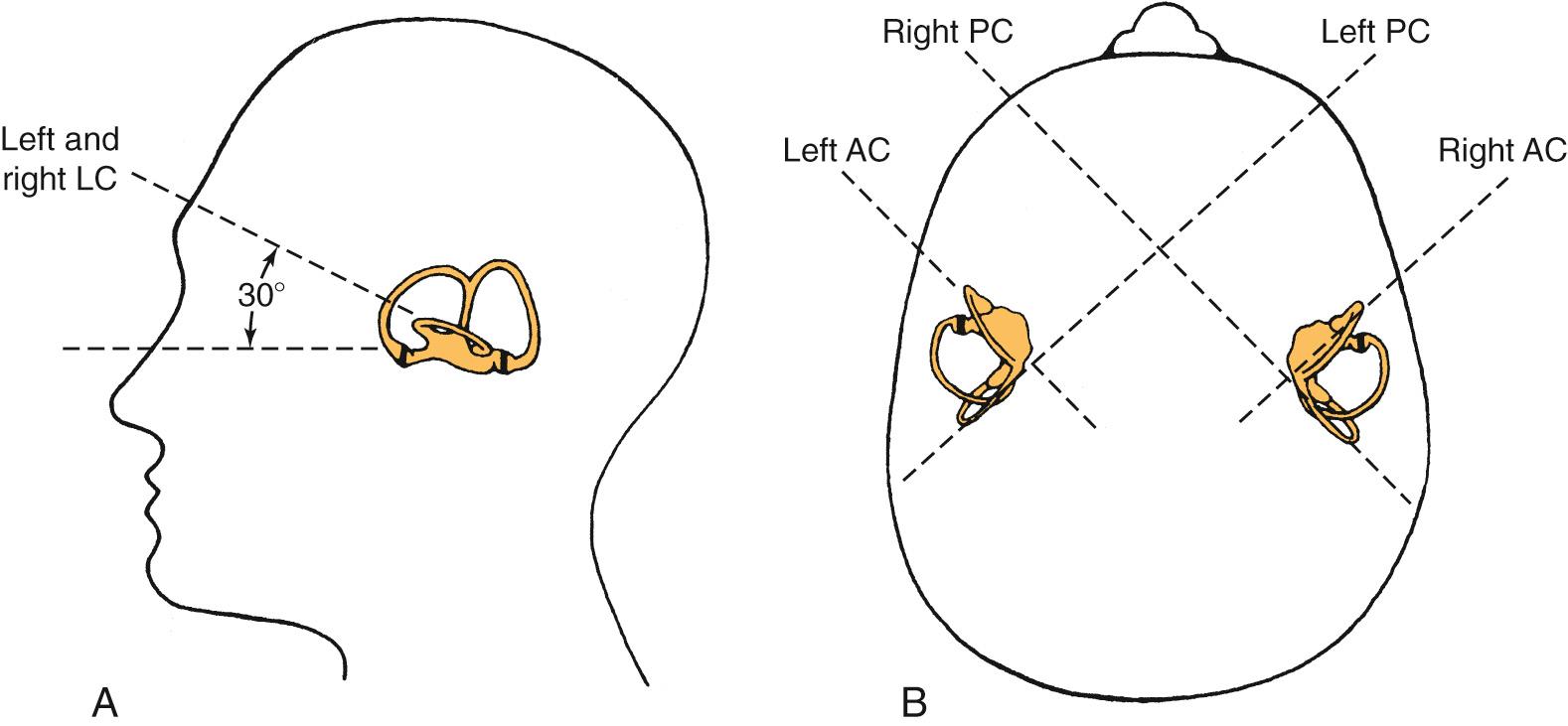
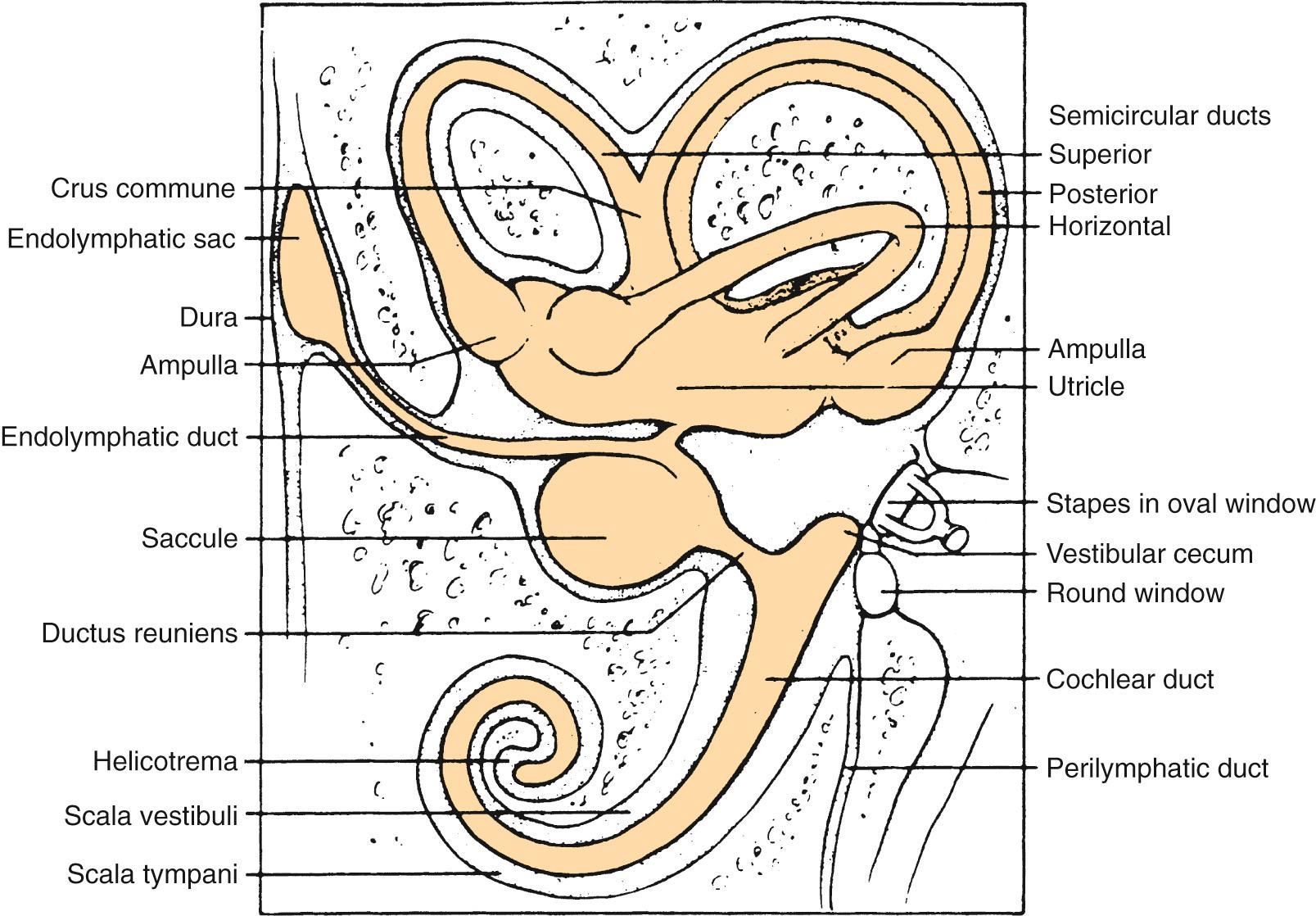
The vestibule is situated between the internal auditory meatus anteromedially and the middle ear cavity laterally. The entrance to the mastoid antrum, the aditus ad antrum, is just lateral to the horizontal semicircular canal. The cochlea sits anterior to the vestibule and is connected to the vestibule by the narrow ductus reuniens ( Fig. 129.4 ; see Fig. 129.3 ). Posterior and lateral to the vestibule are the mastoid air cells. Directly medial is the posterior cranial fossa, into which the endolymphatic duct and sac extend beneath the dura.
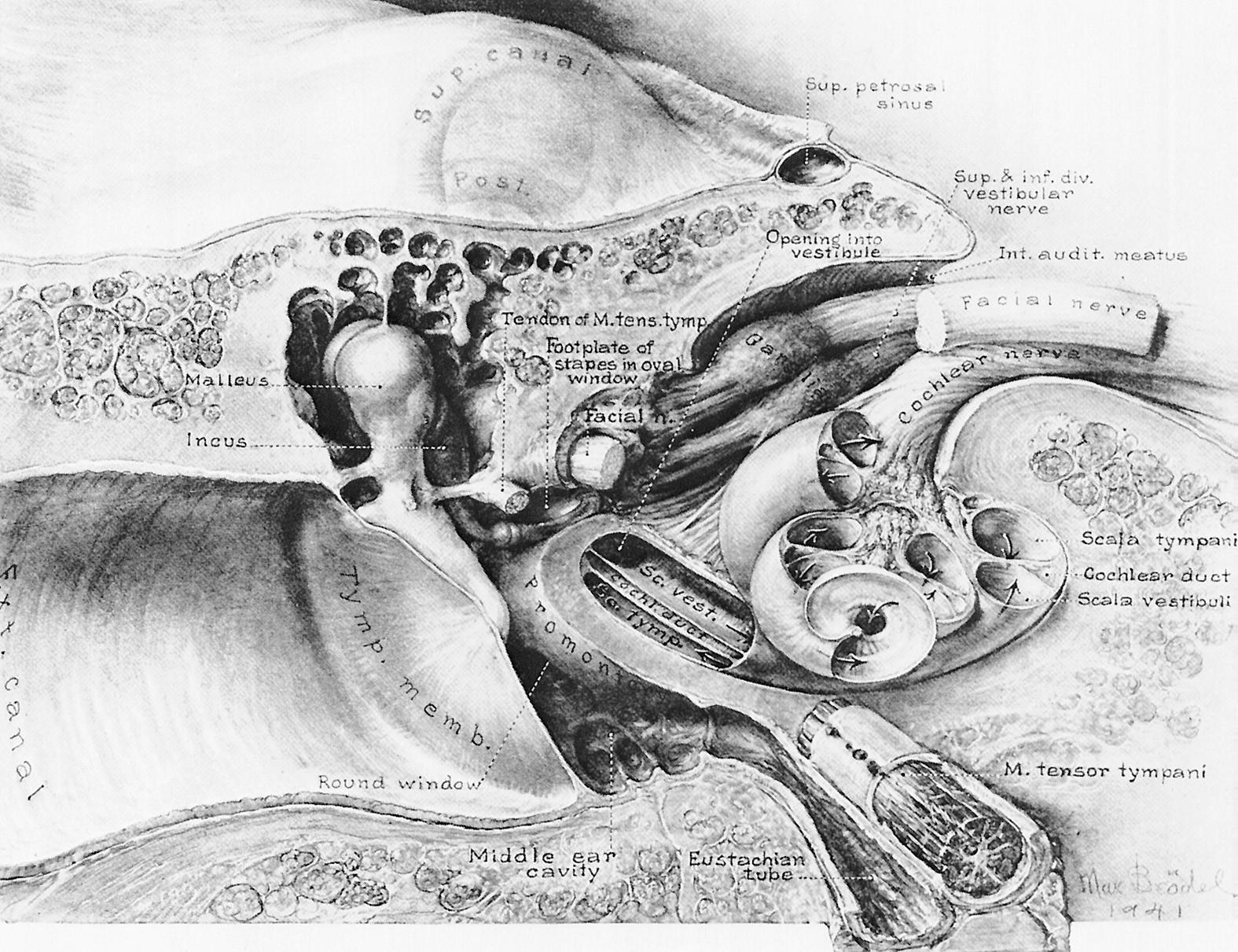
The seventh (facial and intermediate) and eighth (vestibulocochlear) cranial nerves (CNs) emerge from the brain stem laterally at the cerebellopontine angle. They enter the vestibule and cochlea from the internal auditory meatus, which is located medial to a point midway between the cochlea and vestibule. The facial nerve lies anterior and dorsal to the vestibulocochlear nerve. The two nerves separate just inside the meatus, and the facial and intermediate nerves continue laterally in their own canal past the vestibule. When past the vestibule, the facial nerve makes a 90-degree turn inferiorly to exit the temporal bone through the stylomastoid foramen . The vestibulocochlear nerve splits into a vestibular division, which turns posteriorly to supply the vestibule, and a cochlear division, which turns anteriorly to supply the cochlea.
The vestibular (Scarpa) ganglion sits at the bottom of the internal auditory meatus. It has two parts, the superior vestibular ganglion and the inferior vestibular ganglion ( Fig. 129.5 ). Large ganglion cells in the superior and inferior ganglia provide afferent innervation to the central regions of the cristae and maculae, and small ganglion cells innervate the peripheral regions of these end organs (the regional specialization within the end organs is discussed in more detail subsequently). A nerve branch is associated with each ganglion; the superior, or anterior, vestibular nerve supplies the anterior and horizontal cristae and the utricular macula, and the inferior, or posterior, vestibular nerve supplies the posterior canal and saccular macula. In addition, a few small branches anastomose between the larger divisions of CN VIII. One such small branch is Voit's anastomosis, which runs from the superior vestibular nerve to the anterosuperior part of the sacculus. Another is the vestibulocochlear (Oort's) anastomosis, which runs from the inferior vestibular nerve to the cochlear nerve and carries cochlear efferents (see later). In addition, some intermediate nerve fibers cross to the vestibular nerve proximal to the superior vestibular ganglion, and others cross back to the intermediate nerve distal to the Scarpa ganglion. It has been suggested that this facial-vestibular anastomosis carries parasympathetic innervation to the vestibular labyrinth; for details on these and other small fiber connections, see Lindemann.
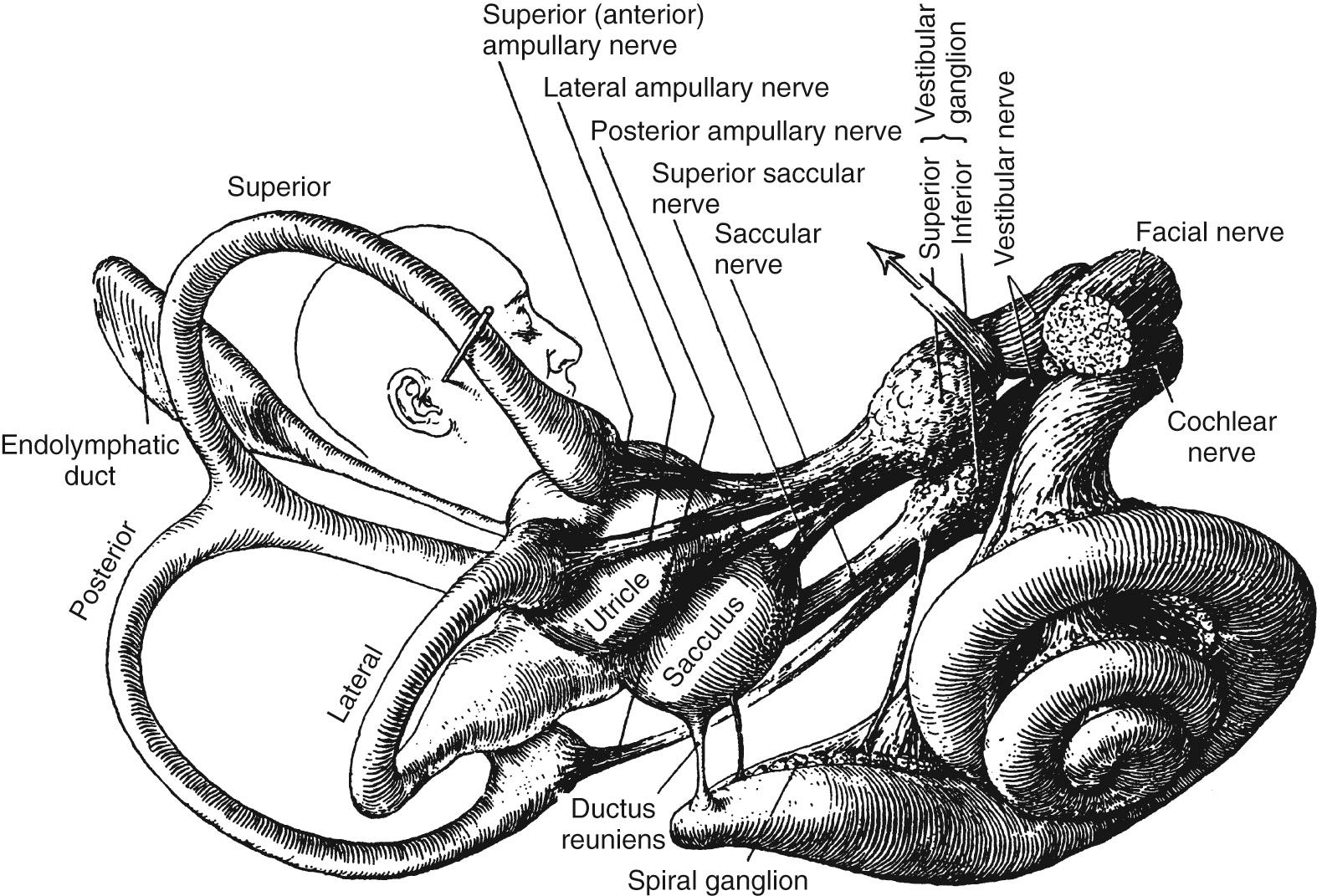
The efferent supply to the vestibular end organs arises from a small group of about 200 neurons lateral to the abducens nucleus and the genu of the facial nerve, the group e neurons . These neurons project ipsilaterally and contralaterally ( Fig. 129.6 ). The contralateral pathway crosses the midline at the level of the facial genu and joins the ipsilateral pathway; both pass ventral to the vestibular nucleus. At this point, they are joined by cochlear efferents that originate from the superior olivary complex (olivocochlear bundle). All of the efferents enter the vestibular nerve and course through the middle of the nerve in a small distinct bundle. At the end organs, these few fibers branch profusely to innervate the entire sensory epithelium. More recent work suggests that the ipsilaterally projecting efferents supply the central regions of the crista, whereas the contralaterally projecting efferents supply the peripheral zone. The efferent fibers terminate as highly vesiculated boutons and make synaptic contacts with hair cells and afferent fibers. For an excellent review of the vestibular efferent system, the reader is referred to the work of Holt and colleagues.
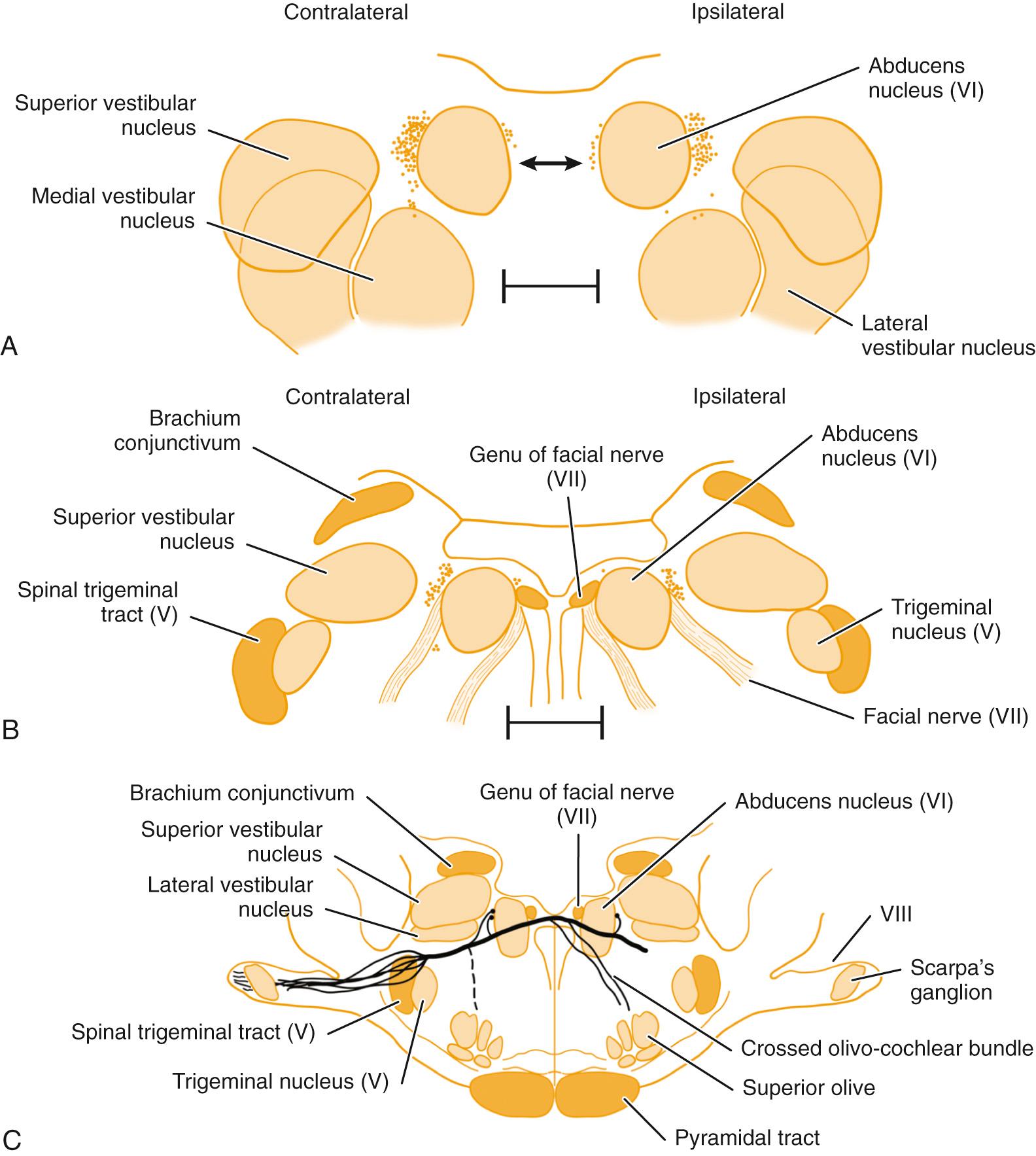
Postganglionic sympathetic fibers from neurons in the superior cervical ganglion also innervate the vestibular end organs; they are of two types, nonvascular and perivascular. The nonvascular sympathetic fibers run among the myelinated afferent fibers. The terminals of these fibers are found as free endings near the cells of Scarpa's ganglion, distal to the ganglion, and beneath the sensory epithelium. They do not seem to penetrate the basement membrane into the sensory epithelium and do not seem to have a direct effect on the hair cells or afferent fibers. Their functional role remains unexplored, along with the functional role of any parasympathetic innervation of the vestibular sensory epithelium.
Become a Clinical Tree membership for Full access and enjoy Unlimited articles
If you are a member. Log in here